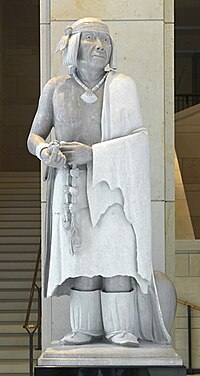Po'pay is a statue of Po’pay (also known as Popé), a Tewa and one of the Pueblo leaders during the Pueblo Revolt against the Spanish in 1680. The statue was carved by Cliff Fragua, a sculptor from Jemez Pueblo, out of a solid block of Tennessee marble.[1]
| Po'pay | |
|---|---|
 The sculpture in the National Statuary Hall Collection | |
| Artist | Cliff Fragua |
| Year | 2005 |
| Medium | Marble sculpture |
| Location | Washington, D.C., United States |
New Mexico was the last state to place its second statue in the National Statuary Hall Collection, making it the 100th statue placed there. Po'pay was the twentieth military leader, the twelfth religious leader, and joined six other Native Americans in the Collection.[2]
History
editIn 1997, New Mexico Senate Bill 404 was introduced by Rep. Manny Aragon (D-Bernalillo) and Nick Salazar (D-Rio Arriba), which nominated Po’Pay to fill the second New Mexico spot in the Hall. The bill was passed and signed into law by Governor Gary E. Johnson. A Statuary Hall Commission was then established whose purpose was to select a sculptor and to raise funds. Fragua was selected as the sculptor.[3]
Carved by Fragua in his studio at Jemez Pueblo over three years, the statue had its first public showing at Ohkay Owingeh pueblo on May 21, 2005, where Po'pay was from. [4] There the statue was blessed before it was allowed to continue on the Washington, D.C., where it was unveiled in the Capitol rotunda on September 22, 2005.
-
Blessing the statue at Ohkay Owingeh.
-
Unveiling of statue at Ohkay Owingeh pueblo
-
scars on statue
See also
editReferences
edit- ^ Romancito, Rick, "Pópay’s Children". Story and photographs by Rick Romancito, Tempo; The Arts and Entertainment Magazine of the Taos News, May 26-June 1, 2005 pp.32-36
- ^ Viles, Philip H., National Statuary Hall: Guidebook for a Walking Tour, Published by Philip H. Viles, Tulsa, OK, 1997
- ^ Sando, Joe S.; Agoyo, Herman (2005). Po’Pay: Leader of the First American Revolution. with contributions by Theodore S. Jojola, Robert Mirabal, Alfoonso Ortiz, Simon J. Ortiz and Joseph H. Suina, foreword by Bill Richardson. Santa Fe, New Mexico: Clear Light Publishing. pp. 128–132.
- ^ Sando & Agoyo 2005, p. 165.
External links
edit- Media related to Po'pay by Cliff Fragua at Wikimedia Commons